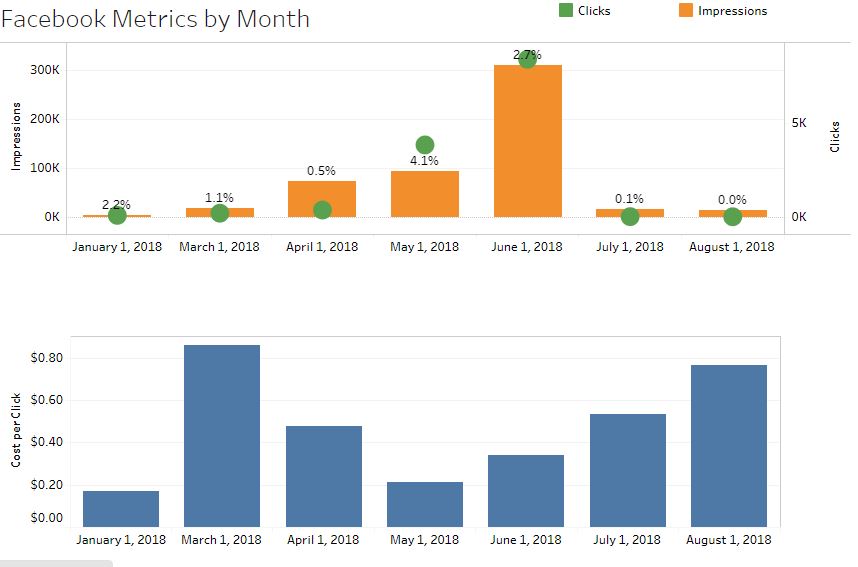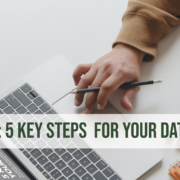Posts
3 Ways to Get to Know Your Customers
/in Customer Engagement, Insights /by Kaeleigh BeebeToday, online purchases and order forms are rapidly replacing the face-to-face or voice-to-voice interactions that drove business and relationships in the past. However, computer-based interactions have also opened up new methods of understanding your customers, and have highlighted the need for a solid customer database. Key data provides crucial information to B2B companies about key traits, including purchasing style, to help you further engage, market to, and acquire more customers. Here are 3 data sources to help you better understand your customer:
1. Understand Customer Transactions
Ask yourself: what types of trends do you see when you look at your transactional data? Are your sales up or down from last year? What are the common products/services that are being purchased?
Simple questions like these can typically be answered using transactional data. Before you dive in too deep, try to understand the big picture of what is being sold and purchased as a whole.
Reflecting on the past helps better us in the present and look ahead to the future.

Your company may be tracking customers through Facebook with digital efforts such as retargeting.
2. Know Your Customers
It’s great to know what products or services your customers are purchasing, but being able to identify individual customers may be the single most useful tool available to the analytic marketer. For some companies, this is easy; their transactional data has the customer information by nature. For others, they rely on loyalty programs or survey data to make generalizations about the purchases their customers are making. In both cases, identifying new and returning customers will help your company understand current trends in their business.
Unsure how your company is tracking customer activity? Ask your sales team what information is being kept in a CRM; you may find that the information is already available.
3. Who’s Who – Tracking New vs. Returning?
Once the identity of the customer is known, you can begin to understand who is a new vs. returning as well as begin learning about the types of customers who might be interested in purchasing from your company. This is important data that can be found by bringing in outside data sources with demographic or firmographic information. Once you can identify key customer traits, you can create customer profiles for those who are likely to become new, those who are likely to leave, or those who are the most profitable.
Creating Smart Data
/in Insights /by Stefan WillimannIf you and your team are spending time trying to wrangle all your various data feeds to find a way to create opportunities for your organization — there is a way to streamline your efforts. You don’t need to find a home for, and a way to use all your data — just the “smart data”.
The flow of data is picking up speed for all marketers, and astute leaders are turning this data into better, more targeted and relevant sales and marketing efforts. But managing all the data from web platforms, marketing technology, mobile devices and the “Internet of Things” is often a daunting and time-consuming task. Rather than focusing on managing the big data flow, we think marketers should try to discover the relatively few data points that can really drive revenue – find your smart data and put it to work!
Start with Customer Segments
The simplest way to begin data-driven messaging to customers and prospects is by understanding that different segments may purchase your products for different reasons or in different ways. For the B2C client we find that demographics or lifestyle factors drive differences in product usage, and for the B2B client – different industry verticals, or other firmographic data mean different likelihoods to buy products and services. Are you able to accurately identify these customer segments and analyze the differences in how they purchase or use your products and services?
Find Your Customers’ Trigger Point
Often times your customers will take some specific actions before they buy – or before they say good-bye (for example, checking their balance before paying off their car loan). These actions should be seen as prompts that can be used to trigger communications to make the sale happen faster, or keep a customer longer. Using predictive models can score your customers and prospects for their likely purchase propensity – but the model itself can identify the behavior triggers that can be turned into automated messaging programs.
Build an Engagement Score
Measure how engaged your customers are with your brand by creating a score that will combine interactions across channels (email, satisfaction, service calls or visits to the store). Keeping it simple with a High-Medium-Low engagement scoring process, you can easily tell if some customers just need more love!
Add “Data Transformations” to Your Data Clean Up
When you combine data from multiple sources you might receive basically the same fields from the different data sources – although they may have different names and slightly different values. For example, “current age” is not as easy to update as “year of birth,” and may actually be the most useful data element for use in marketing campaigns. Build common rules, definitions and data naming conventions so the data can be easily understood, and used efficiently in marketing, sales and operations. Data Transformations are key to making your data smart and actionable.
Trying to gain control of all the data generated by your marketing today can actually slow your progress to a more innovative data-driven approach. Quality over quantity is key! Find your top ten “Smart Data” elements, use them to test more relevant multi-channel efforts, and build in more variables as you grow.
5 Ways to Rev up your Marketing Performance with Data-Driven Fuel
/in Insights /by Stefan WillimannCustomer Insights give great value to marketers when they can be activated through marketing and sales efforts that move the sales needle in the right direction. “Smart customer data” has emerged as a powerful strategic asset for the most successful marketing professionals – and the process of using this data to help define goals, audiences, campaigns, and tactics as well as measuring and analyzing performance makes marketers much more agile and responsive to rapidly changing consumer expectations and behaviors. If you recognize the need to accelerate your marketing with a more data-driven, analytical approach we recommend getting started with some of these ideas:
1. Assess When and How Your Customers Want Communication
 Help customers let you know their communications preferences by making it easy on your privacy pages and in every reply form
Help customers let you know their communications preferences by making it easy on your privacy pages and in every reply form- Once they tell you their preferences – make sure you respond and respect their choices in your campaigns
- Use message testing to persuade your customers to interact with you over multiple channels to build your understanding of what makes them tick
- Keep track of what worked – optimize results and the satisfaction of your customers will grow
2. Use Insights to Drive Your Content Strategy
- Different segments of your audiences will be interested in different types of content. Use insights about your segments in content development
- Determine the types of marketing content and delivery format your key segments crave and respond to the most
- When developing different content, consider where customers are in the sales cycle – are they gathering information and researching the category? Give them an overview of where you stand vs. your competition
3. Master Data-Driven Cross-Selling
- Build a cross sell matrix and keep track of the most likely next-to-buy products for your customers
- Analyze the typical time between purchases, and make sure you trigger a cross sell offer around the time your customers will be going back into the market.
4. Use customer data for digital micro-targeting
- Use digital ad buying platforms to deliver ads directly to your individual customers – with segment specific messages
- Push your current customer data into the platforms. They can build predictive models on the fly to find lookalikes
- Drop digital ads to the same group of people just before and just after direct mail contact to see if you can boost your direct mail results
- Work with your media buying team to pilot some of these innovative 1:1 digital techniques and find out where you get the biggest bang
5. Test into Offer-Optimization
- Create offers with just enough incentive to get your customers and prospects to act
- In addition to monetary, create offers that provide information or interesting content. Too many monetary offers can backfire and train your customers to wait for the best deal
- Use a test and learn approach to get the most response from your product and service offering
Whether your aim is to fine-tune marketing targeting by selecting audiences that will deliver the greatest return, to deliver more relevant messaging, or to find the customers that are ready to leave (or those that are ready to buy) – the answers are often found in your existing customer data. Analyzing data from inside your organization will build customer insights that speed up your marketing performance.
5 Ways to Take Your Marketing Measurement to the Next Level
/in Insights /by Stefan WillimannSmart marketers have the luxury (and challenge!) of using more technologies and measurement tools than ever before, allowing us to project results and profitability, and look at customer and prospect behavior from different angles. While this should allow optimization like never before, campaigns are still often run “one-off,” with no more testing or optimization than before the MarTech boom. Habitually driven by short-term demands and the need to be responsive to quick changes in the markets, we often neglect to take the long view on marketing measurement to pursue long-term campaign improvement. If you’re looking to boost your performance, it’s important to take a look at what drives your ROI and how to effectively develop actionable insights and optimize your marketing performance over time.

A few strategies to consider:
1. Get Alignment on your most important measure of success
Find one or two key measures (e.g., new customers acquired, incremental revenue growth, retained customers, etc.) and make sure each of your marketing efforts are designed to drive results that can prove out success for those specific measures.
2. Create a measurement template for every campaign – and stick to it
Determine how results will be measured and create a measurement template that can be repeated in all your campaigns – how does the response work, who is responsible for measuring and reporting on it, how does the information get into a centralized format, what is the next interaction after the initial response, etc. The more you standardize measurement, the less you have to figure out in the heat of the battle.
3. Standardize Closed-Loop Campaign Measurement
Track your marketing efforts all the way to the sale with sophisticated databases and ecommerce platforms, loyalty programs and smarter data matching. Create a consistent measurement template so ongoing reporting will be easier and have the ability to become standardized. Rely on benchmarks to compare from campaign to campaign so you’ll be able to innovate more easily to boost results.
4. Create a Roadmap for Enhancing Your Marketing Measurement Methods
As you innovate and take advantage of new technologies (e.g. beacons) and/or new data sources (like machine data) your marketing measurement will also need to evolve over time. As you innovate, keep your focus on your key metrics for success. Plan to continuously enhance your measurement methods with the new data to determine the real impact of those innovations. Don’t forget to budget for updates to your database and the design of new measurement methods.
5. Create a Three Year Learning Plan
Often a “point-in-time” campaign analysis misses the big picture. Effectively monitor and evaluate the impact of your efforts over time by setting learning goals that can be tested and proved out over multiple waves of your initiatives. Build long term testing into every effort to keep trying to beat the benchmarks for your most key measures of success.
If you’re under pressure to improve marketing results, these five best practices can improve your operations and drive to optimize. We invite you to take the next step to change your marketing processes to get to repeatable improvements in your marketing ROI.
Build Your Data Strategies
/in Insights /by Stefan WillimannVirtually everything we do produces more data, and it’s a fact that marketers who can capitalize on that data are the winners in their respective industries. Data Equity (the value of your company’s data) has begun to pop up as an asset on corporate balance sheets, and it’s imperative for you to be armed with real-time, actionable analytics and business intelligence to drive smarter marketing, sales and business decisions. Data views need to be easy to understand and customize, when and where you need it.
 SIGMA has spent over 30 years helping our clients capture the hidden value in their data contributing to customer acquisition, sales force optimization, and consumer loyalty. We are poised to share strategies that we know will continue to help you engage and grow your customers – and your client’s customers.
SIGMA has spent over 30 years helping our clients capture the hidden value in their data contributing to customer acquisition, sales force optimization, and consumer loyalty. We are poised to share strategies that we know will continue to help you engage and grow your customers – and your client’s customers.
We’ve engaged our SIGMA thought leaders and curated some insightful and interesting content that will help you consider how to build out your data strategies for the rest of 2018 and beyond. We invite you to join our mailing list so we can share these, and other, very important insights:
- 5 Ways to Take Your Marketing Measurement to the Next Level
- B2B Data 101 eBook
- 100 Ways eBook
- Successful analytics eBook
- Data Driven Success eBook
If there is something you would like to learn more about, please leave a comment below. As always, we are here to help.
Is Your Data Solution Enough?
/in Insights /by Stefan WillimannScanning the headlines of the advertising and marketing trade press, it’s obvious that the marketing services industry is adept at keeping up with and pushing new trends in media, channel integration, and new marketing technologies. From conversations we have with many of our clients and agency partners it seems that many agencies struggle with what could be the industry’s most important challenge for the future; the need to understand and grapple with the mountains of data our clients want to use to achieve their business goals. Many agencies have put their toe in the water with data analysis and management — but is it enough?
Compounding this challenge is the continuing explosion of tech providers to fill in every white space in the marketing landscape. Each of these players is helping to drive the overwhelming amount of ‘Big Data’ that’s washing over the marketing landscape. Many of these tools are intended to allow us to optimize marketing spends and let individuals see unique messaging across a brand’s owned, earned and paid channels – but they end up creating even more silos of confusing data.
 Today, working with client data as well as third party consumer information are essential skills for any agency seeking to build a successful brand. By offering effective data analytics and customer insights, agencies who can no longer keep their clients based on their creative ideas alone are able to productively drive business outcomes and effect corporate direction – making their agency / client relationships more valuable.
Today, working with client data as well as third party consumer information are essential skills for any agency seeking to build a successful brand. By offering effective data analytics and customer insights, agencies who can no longer keep their clients based on their creative ideas alone are able to productively drive business outcomes and effect corporate direction – making their agency / client relationships more valuable.
Client expectations are increasing every day, and keeping up with the demands of real time, data-driven marketing that resonates with their audiences and drives results requires a re-think about data and analytics. Once considered a luxury add on to basic agency services, these analytics and insights have become a necessary component in a brand’s overall marketing plans, most importantly in customer acquisition and growth strategies.
As a result, tech and data-focused agencies are increasingly in high demand. In a survey conducted by eMarketer, 75% of senior marketers surveyed said an agency with marketing data and analytics capabilities would be a deciding factor in agency selection.
Agencies now understand that in addition to their existing capabilities, data and analytic capabilities must be part of their solution. Today, clients expect their agency’s to leverage data successfully to advance the success of their brands. Once more agencies have successfully integrated stronger data and analytics skills they will be better equipped to be the marketing partner brands want and need.
Whether you build, or partner–flexing your data muscles will make your agency/client relationship stronger and more strategic.
So, what’s your data solution?
Partner with a data analytics firm that has depth at data science, best-in-class data tools, and the data governance and environment to integrate, manage, analyze, enrich, and ultimately construct actionable outcomes for your data – effectively building the strongest and most successful brand strategies.
Act now.
SIGMA Data Insights
Subscribe
Stay up to date with insights in your inbox.








